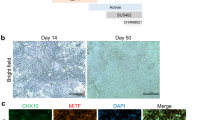Abstract
To investigate the role of Wnt/β-catenin signaling pathway in the restoration of induced pluripotent stem cell-derived retinal pigment epithelium (hiPSC-RPE) after laser photocoagulation. After differentiation of RPE cells from hiPSCs, laser photocoagulation was performed. Activation of Wnt/β-catenin signaling at days 1 and 5 after laser photocoagulation was evaluated by expression of β-catenin. Cell proliferation and alteration in cell-to-cell contact at day 5 after laser photocoagulation with or without Dickkopf-1 (Dkk-1) treatment were studied using ethynyl-2′-deoxyuridine (EdU) assay and zonula occludens-1 (ZO-1) expression analysis, respectively. The mRNA levels of Wnt genes at day 5 after laser photocoagulation were evaluated by quantitative real-time polymerase chain reaction (qRT-PCR). Activation of Wnt/β-catenin signaling at days 1 and 5 after laser photocoagulation was confirmed by β-catenin accumulation in the cytoplasm and nucleus of hiPSC-RPE. Many EdU-positive cells also expressed β-catenin, and the number of EdU-positive cells was decreased at day 5 after laser photocoagulation after Dkk-1 treatment, indicating that Wnt/β-catenin signaling mediated hiPSC-RPE proliferation. ZO-1 expression was not decreased with Dkk-1 treatment at day 5 after laser photocoagulation, indicating that Wnt/β-catenin signaling mediated hiPSC-RPE restoration. At day 5, after laser photocoagulation, mRNA levels of Wnt2b, Wnt3, Wnt5a, Wnt7a, and Wnt10b were increased. Wnt/β-catenin signaling has a crucial role in restoration of hiPSC-RPE proliferation after laser photocoagulation. Manipulation of Wnt/β-catenin signaling while elucidating the underlying mechanisms of RPE restoration might have a therapeutic potential in retinal degenerative diseases.







Similar content being viewed by others
References
Strauss O (2005) The retinal pigment epithelium in visual function. Physiol Rev 85:845–881
Thumann G, Hoffman S, Hinton DR (2006) Cell biology of the retinal pigment epithelium. In: Ryan SJ (ed) Retina, 4th edn. Elsevier Mosby, St. Louis, pp 137–152
Tababat-Khani P, Berglund LM, Agardh CD et al (2013) Photocoagulation of human retinal pigment epithelial cells in vitro: evaluation of necrosis, apoptosis, cell migration, cell proliferation and expression of tissue repairing and cytoprotective genes. PLoS One 8:e70465
Pollack A, Korte GE (1990) Repair of retinal pigment epithelium and its relationship with capillary endothelium after krypton laser photocoagulation. Invest Ophthalmol Vis Sci 31:890–898
von Leithner PL, Ciurtin C, Jeffery G (2010) Microscopic mammalian retinal pigment epithelium lesions induce widespread proliferation with differences in magnitude between center and periphery. Mol Vis 31(16):570–581
Datta S, Cano M, Ebrahimi K et al (2017) The impact of oxidative stress and inflammation on RPE degeneration in non-neovascular AMD. Prog Retin Eye Res 60:201–218
Lu L, Hackett SF, Mincey A et al (2006) Effects of different types of oxidative stress in RPE cells. J Cell Physiol 206:119–125
Zareba M, Raciti MW, Henry MM et al (2006) Oxidative stress in ARPE-19 cultures: do melanosomes confer cytoprotection? Free Radic Biol Med 40:87–100
Forooghian F, Razavi R, Timms L (2007) Hypoxia-inducible factor expression in human RPE cells. Br J Ophthalmol 91:1406–1410
The Diabetic Retinopathy Study Research Group (1976) Preliminary report on effects of photocoagulation therapy. Am J Ophthalmol 81:383–396
The Diabetic Retinopathy Study Research Group (1981) Photocoagulation treatment of proliferative diabetic retinopathy. Clinical application of Diabetic Retinopathy Study (DRS) findings, DRS Report Number 8. Ophthalmology 88:583–600
Hsu J, Maguire MG, Fine SL (2005) Laser prophylaxis for age-related macular degeneration. Can J Ophthalmol 40:320–331
Takahashi K, Tanabe K, Ohnuki M et al (2007) Induction of pluripotent stem cells from adult human fibroblasts by defined factors. Cell 30:861–872
Nguyen HV, Li Y, Tsang SH (2015) Patient-specific iPSC-derived RPE for modeling of retinal diseases. J Clin Med 4:567–578
Muniz A, Ramesh KR, Greene WA et al (2015) Deriving retinal pigment epithelium (RPE) from induced pluripotent stem (iPS) cells by different sizes of embryoid bodies. J Vis Exp 4:96
Muniz A, Greene WA, Plamper ML et al (2014) Retinoid uptake, processing, and secretion in human iPS-RPE support the visual cycle. Invest Ophthalmol Vis Sci 55:198–209
Steinfeld J, Steinfeld I, Coronato N et al (2013) RPE specification in the chick is mediated by surface ectoderm-derived BMP and Wnt signalling. Development 140(24):4959–4969
Drenser KA (2016) Wnt signaling pathway in retinal vascularization. Eye Brain 8:141–146
Han JW, Lyu J, Park YJ et al (2015) Wnt/β-catenin signaling mediates regeneration of retinal pigment epithelium after laser photocoagulation in mouse eye. Invest Ophthalmol Vis Sci 56:8314–8324
Ogata N, Ando A, Uyama M et al (2001) Expression of cytokines and transcription factors in photocoagulated human retinal pigment epithelial cells. Graefes Arch Clin Exp Ophthalmol 239:87–95
Tamiya S, Liu L, Kaplan HJ (2010) Epithelial-mesenchymal transition and proliferation of retinal pigment epithelial cells initiated upon loss of cell-cell contact. Invest Ophthalmol Vis Sci 51:2755–2763
Zarbin MA (2008) Retinal pigment epithelium-retina transplantation for retinal degenerative disease. Am J Ophthalmol 146:151–153
Greene WA, Burke TA, Por ED et al (2016) Secretion profile of induced pluripotent stem cell-derived retinal pigment epithelium during wound healing. Invest Ophthalmol Vis Sci 57:4428–4441
Van Raay TJ, Vetter ML (2004) Wnt/frizzled signaling during vertebrate retinal development. Dev Neurosci 26(5–6):352–358
Shimizu H, Julius MA, Giarré M et al (1997) Transformation by Wnt family proteins correlates with regulation of beta-catenin. Cell Growth Differ 8(12):1349–1358
Ann EJ, Kim HY, Seo MS et al (2012) Wnt5a controls Notch1 signaling through CaMKII-mediated degradation of the SMRT corepressor protein. J Biol Chem 287(44):36814–36829
Funding
This study was financially supported by grants from Basic Science Research Program through the National Research Foundation of Korea (NRF) (No. 2016R1A2B4008376; Seoul, Republic of Korea). This work was partially supported by the Soonchunhyang University Research Fund.
Author information
Authors and Affiliations
Corresponding authors
Rights and permissions
About this article
Cite this article
Cho, I.H., Park, S.J., Lee, S.H. et al. The role of Wnt/β-catenin signaling in the restoration of induced pluripotent stem cell-derived retinal pigment epithelium after laser photocoagulation. Lasers Med Sci 34, 571–581 (2019). https://doi.org/10.1007/s10103-018-2631-5
Received:
Accepted:
Published:
Issue Date:
DOI: https://doi.org/10.1007/s10103-018-2631-5




